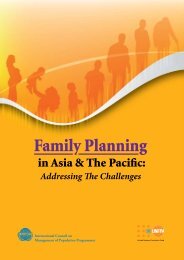Inter-lInkages between PoPulatIon DynamIcs anD DeveloPment In ...
Inter-lInkages between PoPulatIon DynamIcs anD DeveloPment In ...
Inter-lInkages between PoPulatIon DynamIcs anD DeveloPment In ...
Create successful ePaper yourself
Turn your PDF publications into a flip-book with our unique Google optimized e-Paper software.
Addressing <strong><strong>In</strong>ter</strong>-linkages <strong>between</strong> Population Dynamics and Development in the Ninth MalaysiaPlanThe Ninth Malaysia Plan is one of the medium-term plans formulated to operationalise Vision 2020. TheNinth Plan sets out “the macro-economic growth targets as well as the size and allocation of the public sectordevelopment programmes.”The five main thrusts in the Ninth Plan are to:1. Move the economy up the value chain;2. Raise the capacity for knowledge and innovation and nurture ‘first class mentality’;3. Address persistent socio-economic inequality constructively and productively;4. Improve the standard and sustainability of quality of life; and5. Strengthen the institutional and implementation capacity.An analysis of the Ninth Plan showed that population dynamics and its inter-linkages are reflected in many ofthe sectoral plannings, as discussed below.PovertyThough the overall incidence of poverty is low (about 3.6%), nevertheless, the incidence of poverty is moresevere in the rural areas as a large proportion of the poor lived here. Pockets of poverty were identified amongthe disadvantage groups, especially the Orang Asli in Peninsular Malaysia and the Bumiputera in Sabah andSarawak.The objective of the Ninth Plan is to eradicate hardcore poverty and halving overall poverty to 2.8% by 2010.Among the strategies employed are increasing the income share of the bottom 40% households by increasingtheir productivity through human capital development; and creating an enabling environment to promotegreater involvement of the NGOs and the private sector in poverty eradication.Poverty reduction will be further discussed in Chapter 3 on Promising Practices in <strong>In</strong>tegrating PopulationDynamics and Development.EducationThe Ninth Plan will undertake a comprehensive improvement of the education delivery system at all levels:Pre-schooleducationPrimary andsecondaryeducationTertiaryeducationTeacherdevelopmentProgrammes to expand the pre-school education to provide full coverage for children aged5-6 years old. Pre-school teacher training programmes to enhance the quality of teachingand learning plus meet the increasing demand for trained teachers.<strong>In</strong>crease access to quality education, especially in rural areas, and Sabah and Sarawak.Reduce and later on to eliminate the incidence of school drop-outs to ensure that allstudents complete at least 11 years of schooling. Program Pembestarian Sekolah will beimplemented to enable teachers to integrate ICT in teaching, learning and management.Measures to bridge the performance gap <strong>between</strong> students in the rural and urban schools,particularly for Mathematics, Science and English subjects.Greater access to tertiary education to achieve the target of 40% participation rate. Expandenrolment at the post-graduate level to meet the target of 25% of the total enrolment atdegree levels in 2010. Programme to increase the enrolment of post-graduate students,especially in science and technology programmes. Continue financial assistance to facilitatestudents to acquire higher education.Program Khas Pensiswazahan Guru will be implemented to increase the quality andprofessionalism of teachers in order to achieve the target of making all secondary schoolteachers and 25% primary school teachers as graduate teachers by 2010. Review trainingcurriculum to improve subject content, enhance pedagogical skills and enable greaterapplication of ICT in education.19














